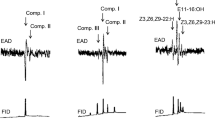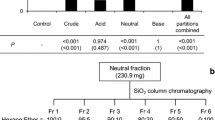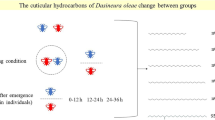Abstract
The primary sex pheromone components of the female spruce budworm, Choristoneura fumiferana (Clem.) (Lepidoptera: Tortricidae), are (E)- and (Z)-11-tetradecenal, produced in 95:5 ratio. However, male flight responses to calling females in a wind tunnel were faster and maintained longer than responses to any synthetic aldehyde blend. Analyses of cuticular extracts from spruce budworm adults revealed series of n-alkanes and n-monoalkenes with predominantly odd numbers of carbon atoms from C23- C29 in both sexes. (Z,Z,Z)-3,6,9-tricosatriene and (Z,Z,Z)-3,6,9-pentacosatriene were identified only in cuticular extracts from females. Pheromonally naïve males showed wing fanning and circling responses to forewing scales from females but not to scales from males. Males also exhibited the same strong responses to scales excised from pharate females, indicating that the pheromone components are produced by females prior to emergence. (Z)-11-hexadecenal and (Z)-5-tricosene enhanced male responses to the primary sex pheromone aldehydes in wind tunnel bioassays, including higher proportions of in-flight and copulatory responses by males and increased time on the source. Addition of (Z,Z,Z)-3,6,9-tricosatriene to the 95/5 blend of (E)- and (Z)-11-tetradecenal released close-range copulatory responses including abdomen curling on treated septa. We propose that the sex pheromone blend of C. fumiferana is composed of the 95/5 blend of (E)- and (Z)-11-tetradecenal as primary components, with (Z)-11-hexadecenal, (Z)-5-tricosene and (Z,Z,Z)-3,6,9-tricosatriene fulfilling secondary roles in orientation and close-range courtship.

Similar content being viewed by others
References
Alford AR, Silk PJ (1983) Behavioral effects of secondary components of the sex pheromone of western spruce budworm (Choristoneura occidentalis) Free. J Chem Ecol 10:265–270
Alford AR, Silk PJ, McClure M, Gibson C, Fitzpatrick J (1983) Behavioral effects of secondary components of the sex pheromone of the eastern spruce budworm Choristoneura fumiferana Clem. Can Entomol 115:1053–1058
Bergh JC, Eveleigh ES, Seabrook WD (1988) The mating status of field-collected male spruce budworm, Choristoneura fumiferana (Clem.) (Lepidoptera:Tortricidae) in relation to trap location, sampling method, sampling date, and adult emergence. Can Entomol 120:821–830
Blomquist GJ, Bagnères A-G (eds) (2010) Insect hydrocarbons: biology, biochemistry, and chemical ecology. Cambridge University Press, Cambridge, UK
Cabrera A, Eiras AE, Gries G, Gries R, Urdenata N, Mirás B, Badji C, Jaffe K (2001) Sex pheromone of tomato fruit borer, Neoleucinodes elegantalis. J Chem Ecol 27:2097–2107
Clément JL (1982) Phéromones d'attraction sexuelle des termites européens du genre Reticulitermes (Rhinotermitidae). Mécanismes comportementaux et isolements spécifiques. Biol Behav 7:55–68
Dunkelblum E, Tan SH, Silk PJ (1985) Double bond location in mono-unsaturated fatty acids by dimethyldisulfide derivatization and mass spectrometry; application to analysis of fatty acids in pheromone glands of four lepidoptera. J Chem Ecol 11:265–277
Evenden ML, McLaughlin JR (2004) Initial development of an attracticide formulation against the oriental fruit moth Grapholita molesta (Lepidoptera: Tortricidae). Environ Entomol 33:213–220
Gibb AR, Pinese B, Tenakanai D, Kawi AP, Bunn B, Ramankutty P, Suckling DM (2007) (Z)11-hexadecenal and (3Z,6Z,9Z)-tricosatriene: sex pheromone components of the red banded mango caterpillar Deanolis sublimlalis. J Chem Ecol 33:579–589
Ginzel MD, Millar JG, Hanks LM (2003) Z9-pentacosene-contact sex pheromone of the locust borer Megacyllene robinae. Chemoecology 13:135–141
Grant GG (1987) Copulatory behaviour of spruce budworm, Choristoneura fumiferana (Lepidoptera: Tortricidae): experimental analysis of the role of the sex pheromone and associated stimuli. Ann Entomol Soc Am 80:78–88
Hall DR, Farman DI, Dominguez JC, Pajares JA (2017) Female sex pheromone of the cone moth, Dioryctria mendacella: investigation of synergism between TypeI and Type II pheromone components. J Chem Ecol 43:433–442. doi:10.1007/s10886-017-0846-8
Harvey GT (1996) Genetic relationships among Choristoneura species (Lepidoptera: Tortricidae) as revealed by isozymes studies. Can Entomol 128:245–262
Howard RW, Blomquist GJ (2005) Ecological, behavioural and biochemical aspects of insect hydrocarbons. Annu Rev Entomol 50:371–393
Kettela EG, Silk PJ (2005) Development of a pheromone formulation for use in early intervention pest management strategies of the spruce budworm Choristoneura fumiferana (Clem.). Final report, SERG-1 Project 614. [online] URL: http://atl.cfs.nrcan.gc.ca/sprucebudworm/
Kettela EG, Holmes SE, Silk PJ (2006) Results of aerially applied Disrupt® microflakes on spruce budworm mating success, Ontario, 2005. Final report, SERG-I, NRCan, CFS – AFC, Fredericton, NB, Canada [online] URL: http://atl.cfs.nrcan.gc.ca/sprucebudworm/
Kuenen LPS, Rowe HC (2006) Cowpea weevil flights to a point source of female sex pheromone: analyses of flight tracks at three wind speeds. Physiol Entomol 31:103–109
Lumley LM, Sperling FAH (2011a) Life-history traits maintain the genomic integrity of sympatric species of the spruce budworm (Choristoneura fumiferana) group on an isolated forest island. Ecol Evolut 1:119–131
Lumley LM, Sperling FAH (2011b) Utility of microsatellites and mitochondrial DNA for species delimitation in the spruce budworm (Choristoneura fumiferana) species complex (Lepidoptera:Tortricidae). Mol Phylogenet Evol 58:232–243
McMorran A (1965) A synthetic diet for the spruce budworm, Choristoneura fumiferana (Clem.) (Lepidoptera: Tortricidae). Can Entomol 97:58–62
Millar JG (2000) Polyene hydrocarbons and epoxides: a second major class of lepidopteran sex attractant pheromones. Annu Rev Entomol 45:575–604
Millar JG, Grant GG, McElfresh JS, Strong W, Rudolph C, Stein JD, Moreira JA (2005) (3Z, 6Z, 9Z, 12Z, 15Z)-Pentacosapentaene, a key pheromone component of the fir coneworm moth, Dioryctria abietivorella J. Chem Ecol 31:1229–1234
Palaniswamy P, Seabrook WD (1978) Behavioural responses of the female eastern spruce budworm, Choristoneura fumiferana (Lepidoptera:Tortricidae) to the sex pheromone of her own species. J Chem Ecol 4:649–655
Palaniswamy P, Ross RJ, Seabrook WD, Lonergan GC, Wiesner CJ, Tan SH, Silk PJ (1982) Mating suppression of caged eastern spruce budworm moths in different pheromone atmospheres at high population densities. Econ Entomol 75:989–993
Rhainds M, Kettela E, Silk PJ (2012) Thirty-five years of pheromone-based mating disruption studies with spruce budworm, Choristoneura fumiferana (Lepidoptera:Tortricidae): a review. Can Entomol 144:379–395
Sanders CJ (1984) Sex pheromone as a trigger of moth dispersal. In: Recent advances in spruce budworms research, proc CANUSA spruce budworms res symp, Bangor, Maine, Sept 1984. pp 113–114 Canadian Forest Service, ISBN 0-662-14202-0
Sanders CJ, Lucuik GS (1992) Mating behavior of spruce budworm moths Choristoneura fumiferana (Clem.) (Lepidoptera:Tortricidae). Can Entomol 124:273–286
Sanders CJ, Silk PJ (1982) Disruption of spruce budworm mating using Hercon plastic laminated flakes. CFS information report, GLFRC, Sault Ste. Marie, 1982. Report no. O-X-335
Sanders CJ, Weatherston J (1976) Sex pheromone of the eastern spruce budworm (Lepidoptera:Tortricidae): optimum blend of trans- and cis-11-tetradecenal. Can Entomol 108:1285–1290
SAS Institute (1999) Proprietary Software release 9.2 SAS Institute Inc, Cary
Silk PJ, Eveleigh ES (2016) Pheromone communication, behavior and ecology in the north American Choristoneura genus. In: J Allison, R Cardé (eds) Pheromone communication in moths: evolution, behavior and application, University of California Press, ISBN: 9780520278561
Silk PJ, Kuenen LPS (1984) Sex pheromones and their potential for the control of forest insects in Canada. An ACS monograph. Chemical and biological implications of forestry insect control, ACS, V238
Silk PJ, Kuenen LPS (1986) Spruce budworm (Choristoneura fumiferana) pheromone chemistry and behavioral responses to pheromone components and analogues. J Chem Ecol 12:367–383
Silk PJ, Kuenen LPS (1988) Sex pheromones and behavioral biology of the coniferophagous Choristoneura. Annu Rev Entomol 33:83–101
Silk PJ, Tan SH, Wiesner CJ, Ross RJ, Lonergan GC (1980) Sex pheromone chemistry of the eastern spruce budworm, Choristoneura fumiferana. Environ Entomol 9:640–644
Silk PJ, Sweeney J, Wu J, Sopow S, Mayo P, Magee D (2011) The contact sex pheromone chemistry and behavior of Tetropium fuscum (F.) and Tetropium cinnamopterum (L.) Kirby (Coleoptera:Cerambycidae). Environ Entomol 40:714–726
Strong WB, Millar JG, Grant GG, Moreira JA, Chong JM, Rudolph C (2008) Optimization of pheromone lure and trap design for monitoring the fir coneworm, Dioryctria abietivorella. Entomol Exp Appl 126:67–77
Underhill EW, Palaniswamy P, Abrams SR, Bailey BR, Steck WF, Chisholm MD (1983) Triunsaturated hydrocarbons, sex pheromone components of Caenurgina erechtea. J Chem Ecol 9:1413–1423
Wang H-L, Zhao C-H, Millar JG, Cardé RT, Löfstedt C (2010) Biosynthesis of unusual moth pheromone components involves two different pathways in the navel Orangeworm, Amyelois transitella. J Chem Ecol 36:535–547
Wolf WA, Roelofs WL (1987) Reinvestigation confirms action of Δ11-desaturases in spruce budworm moth sex pheromone biosynthesis. J Chem Ecol 13:1019–1027
Xiao W, Honda H, Matsuyama S (2011) Monoenyl hydrocarbons in female body wax of the yellow peach moth as synergists of aldehyde pheromone components. J Chem Ecol 46:239–246
Xiao W, Matsuyama S, Ando T, Millar JG, Honda H (2012) Unsaturated cuticular hydrocarbons synergize responses to sex attractant pheromone in the yellow peach moth, Conogethes punctieralis. J Chem Ecol 38:1143–1150
Acknowledgements
We wish to thank a past collaborator (with PS), L. P. S. “Bas” Kuenen, for inspiration and Chris Sanders (deceased) for valuable discussions over many years. All experiments reported here comply with the laws of Canada.
Author information
Authors and Affiliations
Corresponding author
Rights and permissions
About this article
Cite this article
Silk, P.J., Eveleigh, E., Roscoe, L. et al. Unsaturated Cuticular Hydrocarbons Enhance Responses to Sex Pheromone in Spruce Budworm, Choristoneura fumiferana . J Chem Ecol 43, 753–762 (2017). https://doi.org/10.1007/s10886-017-0871-7
Received:
Revised:
Accepted:
Published:
Issue Date:
DOI: https://doi.org/10.1007/s10886-017-0871-7




